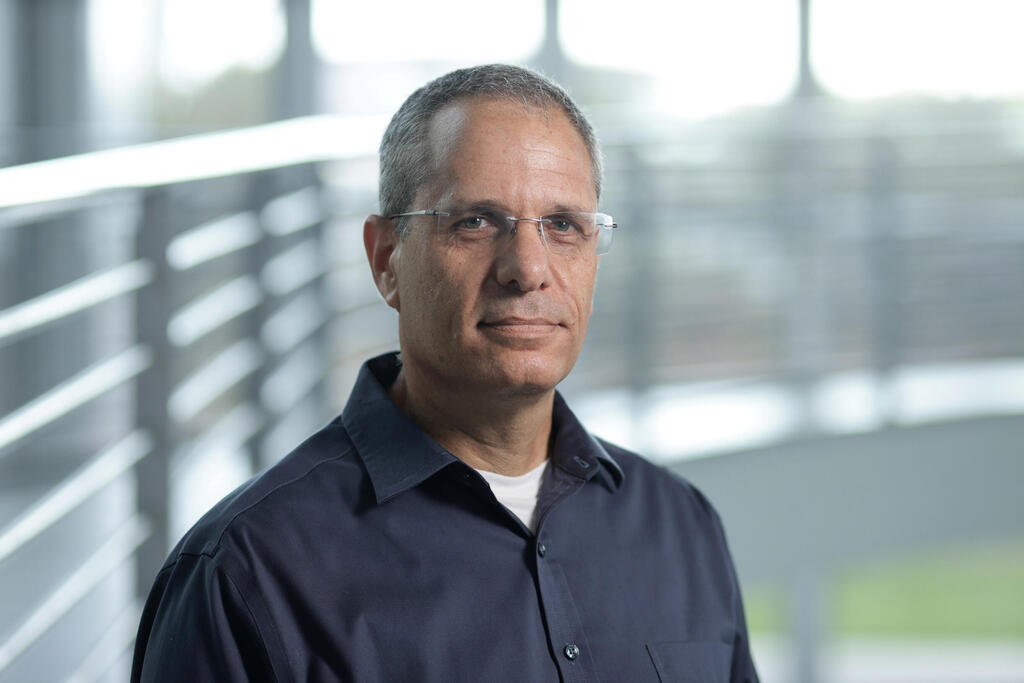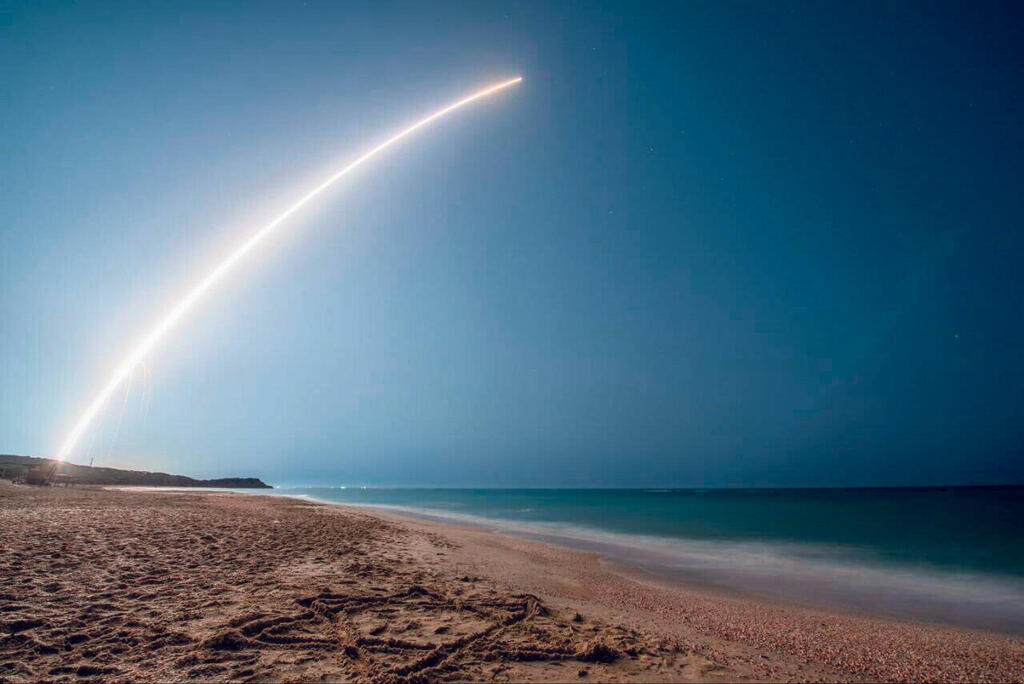
Star wars: "Israel is interested in space weapons. Every one of our satellites is a machine of war"
In his first interview since taking office a year ago, Avi Berger, Head of the Space and Satellite Administration within the Directorate for Defense Research and Development (DDR&D)'s at the Ministry of Defense, takes Calcalist behind the scenes of the launch of the Ofek-13 satellite, discusses the plan to cover the sky with both large and small satellites, and explains why he believes competition is essential
"Launching a satellite is a wild and complicated operation," says Avi Berger, Head of the Space and Satellite Administration within the Directorate for Defense Research and Development (DDR&D)'s at the Ministry of Defense, describing the launch of the Ofek-13 satellite at the end of March. "Closing the sky, restricting the movement of vessels at sea and making countless coordinations with Amab (Israeli Military Intelligence) and with the IAA control rooms until the last minute. This is an event that must end with zero malfunctions. Everyone who is involved in it understands that any mistake, any deviation in a tenth of a second, will send this whole thing to Kingdom Come and the whole thing will explode."
The launch included the Shavit 2 satellite launcher, which rises to the height of a 7-story building, and inside it the Ofek 13 satellite, whose price is estimated at several hundred million shekels. Hundreds of engineers and technicians worked for several years on its development and production at the Israel Aerospace Industries space complex. A powerful engine of the government defense company Tomer, which is a center of national knowledge regarding rocket propulsion, carried the huge launcher and with it the spy satellite into space within seconds.
Like every other satellite that Israel has launched since 1988, Ofek-13 was also launched towards the west, while every other country that launches into space is aimed towards the east, the direction of the Earth's rotation. For Israel, the launch in the opposite direction further complicates the already difficult task, and still, this is better than a scenario of failure that would lead to the scattering of the fragments of the launcher and the satellite over inhabited territory, and possibly even that of an enemy state.
"You provide more security to the country"
Each Ofek series intelligence satellite that Israel launches brings with it more recent technological innovation and in a way compliments the collection capabilities of the IDF's intelligence wing through its satellite unit 9900. Like other observation satellites, Ofek 13 orbits the earth every hour and a half, at an altitude of about 400 km. Being a SAR (radar-based) satellite, it photographs objects of tens of centimeters in size from space, at any point on Earth, day and night, and in all weather conditions, which means even in the case of intense sandstorms and heavy clouds.
These capabilities are especially noticeable compared to those of electro-optical satellites (based on a camera) which do indeed see things from space that SAR satellites will not see even with a magnifying glass, but an unruly cloud that will pass over the area of interest to which they aimed could disrupt an important mission and create an intolerable "hole" in the flow of intelligence operations in a distant land. Berger does not specify the number of satellites available to the defense establishment, but according to him, Ofek 13 brings its operators new, significant and advanced capabilities with respect to each of the satellites it maintains in space.
Is it like going from an old Nokia device to the iPhone 15, or is it merely more of the same, just with cosmetic improvements here and there?
"Unequivocally, every satellite we launch is better than the previous one. In the case of Ofek 13, it's closer to this comparison, that between an old Nokia device and a modern and up-to-date device, the upgrade is dramatic. I can't say much, but it's significant. When you bring something like this up to space in such a complex period, you provide more security to the country. This is the ability to launch an electromagnetic beam from a height of hundreds of kilometers to the ground and based on what comes back we can reach all kinds of insights. We can put together a picture based on several parameters, and in the end we can detect changes, even minor ones."
Rafael is breathing down its back
The Ofek series satellites are produced by the IAI, which is considered the leader of the Israeli space industry, but this may only be temporary. In the background is the competitor Rafael, also fully owned by the state, which has been promoting its own space program for several years. Large parts of it are secret, but the concept it presented to the security establishment is innovative, and may change the rules of the game in the field of military satellites and undermine and shake up the long-standing hegemony of IAI in the field.
Rafael's idea challenges everything we knew in the field of "traditional" intelligence satellites, such as those of the IAI and the American giants Lockheed Martin, Boeing and Northrop Grumman, which on the one hand manage high-quality space programs, and on the other hand are stuck in the distant past, especially in regards to size and price.
Compared to the traditional satellite, whose construction in Israel takes about 3-4 years, weighs several hundred kilograms and costs several hundred million dollars, and there is always the risk that it will explode during launch, disappear in space or not respond to its operators, Rafael offers a speed and pace that even Ofek 13, which is considered one of the best intelligence satellites in the world, cannot provide. In a reality where even waiting 90 minutes for a satellite to hover over some point of interest on Earth is considered an eternity, it offers bands of dozens of cheap nano-satellites who can provide a continuous flow of valuable operational intelligence. So the resolution may not be as fine as that of Ofek 13, but good enough to make urgent tactical decisions on the battlefield.
The average duration of a satellite's flight path over the Middle East is about 10 minutes, during which it can photograph Gaza, the Lebanese border, parts of Syria and interesting places in Iran. The next time it will be relevant to unit 9900 will only be in 80 minutes, which is a long time. According to Rafael's concept, if a satellite from its constellation of satellites passes over a point of interest in Iran and does not take a picture of it because a cloud came into its frame, in a few moments another nano-satellite from the same constellation will pass by, aim a lens and complete what its predecessor did not.
Does the IAI feel that the Ministry of Defense is placing it in competition with other companies?
"Competition is always a good thing and they know it, even though they don't like it. The most important thing is that in the end they admit that it makes them better."
"The best picture will also be the last"
The most surprising satellite in Israel's spy satellite array is Ofek 5, which was launched into space in May 2002. It was designed for a period of 5 years of operation and since then, some 21 years later, is still taking pictures and as far as is known is the oldest intelligence satellite in the world. It was built by the IAI, which invested a lot in it after learning from the failure of the Ofek 4 satellite in 1998. A central rule in the production of a satellite is to invest in the immunity and durability of its systems. "They invested so much in it that its life was extended more than four times. From the point of view of the IAI, this could also be a double edged sword. The fact that it lived for many more years allowed us to save on a satellite or, alternatively, allowed us to expand our satellite constellation," he says.
The latest estimate as to its life span is a year, plus or minus, but on the other hand it's Ofek 5 so it's hard to know: "I don't think it will be with us much longer. As it fades and lowers its altitude towards the Earth, it will take better resolution images and, paradoxically, the best image will also be its last picture. Below an altitude of 300 km it is almost impossible to get anything because of the friction that affects the stability of the satellite."
Regarding the flourishing of the Israeli satellite industry, he says that "they all came out of the same industry, which is amazing and dramatic. All these satellites are working right now in space, in a completely normal way and provide their operators with outputs that are top of the line. Every such satellite is a machine of war."
What will Israel's "security space" look like in 10 years?
"For me, 10 years is tomorrow morning. Looking to 2040, I see wider constellations of satellites that will allow us continuity in the areas that interest us and will guarantee us continued security superiority in space and our relative advantage over our enemies. It is difficult for me to say much beyond what I have said on the subject, but this will manifest itself in a wide variety of satellites, large and small, that will operate in all kinds of constellations."
Is a "space weapon" something that interests Israel?
"The world is going in that direction and we are examining it. Whether, how or when we will make a decision or if such a decision has already been made, I am not hinting at anything."
What could it be?
"For example, anything that can prevent satellites from doing what they can do. By any means, whether it is kinetic or not. We examine everything that happens and can affect us and we are constantly considering such things. The space race also creates such challenges."
Berger grew up in Dimona, a town in the periphery, and his father worked in a textile factory. He remembers that even as a teenager he was aware that he was exposed to much less than the possibilities to which his peers from the center of the country were exposed. This understanding drove him even further.
He studied all the right subjects, physics, mathematics, English, electronics and electricity at the level of 5 units of matriculation in a state high school. And yet, he knows that his case is not representative: "The percentage of students from the periphery who are there is very low. It's still like that today."
As the commander of a very prestigious intelligence unit who himself grew up and came from the periphery, do you have a different point of reference for the boy from Ofakim who is competing for the same place in 8200 with a more privileged boy from Herzliya?
"We have to understand the situation, that on the one hand you want the best youth and the army gives me the opportunity to get my hands on the best first, and I don't want to miss it. And our selection process is precise. We get the best quality youth. Every 18-year-old is like a fireball in your hand. Make no mistake: those who operate the satellites of the State of Israel are 18 and 19 years old, and they are the best of the best in this world."















